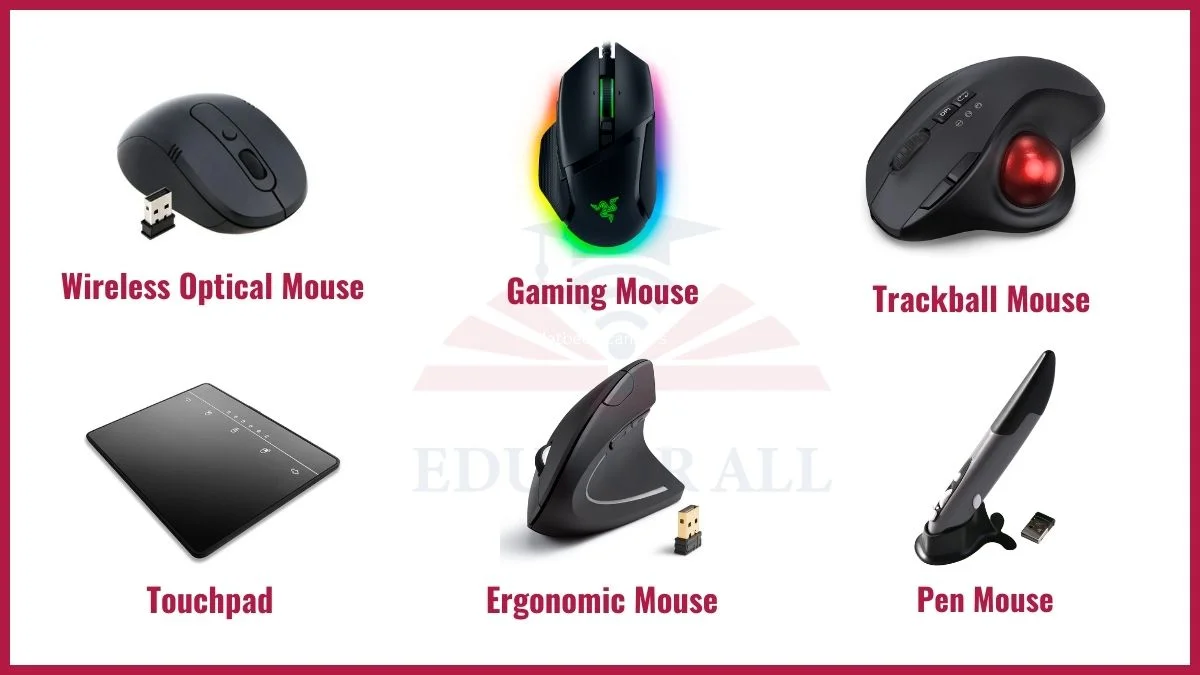A computer mouse is a handheld input device that allows users to interact with a computer by moving a cursor on the screen. It typically includes buttons for executing commands and a scroll wheel for navigating content.
Examples of Mouse include wireless optical mouse, gaming mouse, trackball mouse, touchpad, pen mouse, and more.
Examples of Mouse
Here are the best examples of mouse:

1. Wireless Optical Mouse
A wireless optical mouse is the best example of a computer mouse. It operates without a physical connection, using radio frequency or Bluetooth technology to communicate with the computer. This allows users greater freedom of movement, making it an ideal choice for those who prefer a clutter-free workspace.
The wireless optical mouse typically has a range of 10 meters or more, providing flexibility in positioning.
2. Gaming Mouse
A gaming mouse is designed specifically for gaming fans. It features high-precision sensors, customizable buttons, and ergonomic designs to enhance gaming performance. With adjustable DPI settings, gamers can control the sensitivity of the mouse for different gaming scenarios.
Some gaming mice offer DPI levels exceeding 16,000, providing precise control for competitive gaming.
3. Trackball Mouse
A trackball mouse is an alternative design where a ball is used to control the cursor. Users rotate the ball with their thumb or fingers to move the pointer. This design is particularly helpful for users with limited desk space and those who experience discomfort with traditional mice.
Trackball mice are known for reducing wrist strain as they eliminate the need for constant movement.
4. Touchpad
Touchpads are commonly associated with laptops, external touchpads can be used as mice for computers. They are sensitive to touch and gestures, allowing users to navigate the computer screen with ease. This compact and integrated design is convenient for users on the go.
Some touchpads support multi-touch gestures, providing advanced functionalities like pinch-to-zoom and two-finger scrolling.
5. Ergonomic Mouse
An ergonomic mouse is crafted with user comfort in mind. It features a design that supports a natural hand position, reducing strain and discomfort during prolonged computer use. Ergonomic mice often come in various shapes and sizes to accommodate different hand sizes and grip preferences.
Studies suggest that ergonomic mice can help prevent musculoskeletal disorders associated with extended computer use.
6. Air Mouse
An air mouse operates by detecting motion in the air, allowing users to control the cursor by waving the mouse in the desired direction. This innovative design is particularly useful for presentations or situations where a traditional mouse surface is unavailable.
Air mice often feature gyroscopic sensors for precise and responsive cursor control.
7. Vertical Mouse
A vertical mouse is designed to be held in a handshake position, reducing the strain on the wrist and forearm. This ergonomic design promotes a more natural and comfortable hand posture, making it suitable for individuals prone to wrist pain or carpal tunnel syndrome.
Vertical mice have been shown to alleviate wrist discomfort in some users compared to traditional mice.
8. Pen Mouse
A pen mouse resembles a stylus or pen and is operated by moving it across a surface. This design is beneficial for graphic designers and artists who require precision and control for tasks like drawing and editing. Pen mice often come with pressure sensitivity for varying line thickness.
Pen mice are popular among digital artists for their ability to mimic the feel of traditional drawing tools.
9. Finger Mouse
A finger mouse is a small, compact device worn on the user’s finger, allowing them to control the cursor by moving their finger across a surface. This portable design is convenient for users on the go and can be an alternative for those who find traditional mice cumbersome.
Finger mice are often used in presentations and are favored for their portability.
10. Tactile Feedback Mouse
A tactile feedback mouse enhances user interaction by providing physical sensations like vibrations or clicks. This can be useful in gaming or when precise feedback is necessary. Tactile feedback mice often have programmable buttons for customization.
Tactile feedback mice aim to improve user experience by adding a sense of touch to computer interactions, enhancing immersion in certain applications.

